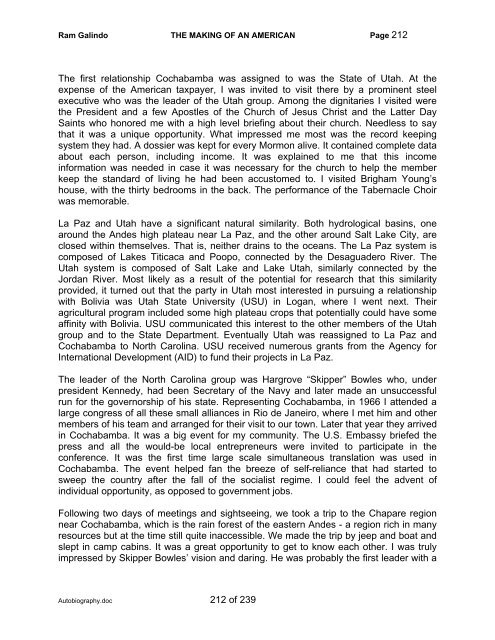Autobiography - The Galindo Group
Autobiography - The Galindo Group
Autobiography - The Galindo Group
You also want an ePaper? Increase the reach of your titles
YUMPU automatically turns print PDFs into web optimized ePapers that Google loves.
Ram <strong>Galindo</strong> THE MAKING OF AN AMERICAN Page 212<br />
<strong>The</strong> first relationship Cochabamba was assigned to was the State of Utah. At the<br />
expense of the American taxpayer, I was invited to visit there by a prominent steel<br />
executive who was the leader of the Utah group. Among the dignitaries I visited were<br />
the President and a few Apostles of the Church of Jesus Christ and the Latter Day<br />
Saints who honored me with a high level briefing about their church. Needless to say<br />
that it was a unique opportunity. What impressed me most was the record keeping<br />
system they had. A dossier was kept for every Mormon alive. It contained complete data<br />
about each person, including income. It was explained to me that this income<br />
information was needed in case it was necessary for the church to help the member<br />
keep the standard of living he had been accustomed to. I visited Brigham Young’s<br />
house, with the thirty bedrooms in the back. <strong>The</strong> performance of the Tabernacle Choir<br />
was memorable.<br />
La Paz and Utah have a significant natural similarity. Both hydrological basins, one<br />
around the Andes high plateau near La Paz, and the other around Salt Lake City, are<br />
closed within themselves. That is, neither drains to the oceans. <strong>The</strong> La Paz system is<br />
composed of Lakes Titicaca and Poopo, connected by the Desaguadero River. <strong>The</strong><br />
Utah system is composed of Salt Lake and Lake Utah, similarly connected by the<br />
Jordan River. Most likely as a result of the potential for research that this similarity<br />
provided, it turned out that the party in Utah most interested in pursuing a relationship<br />
with Bolivia was Utah State University (USU) in Logan, where I went next. <strong>The</strong>ir<br />
agricultural program included some high plateau crops that potentially could have some<br />
affinity with Bolivia. USU communicated this interest to the other members of the Utah<br />
group and to the State Department. Eventually Utah was reassigned to La Paz and<br />
Cochabamba to North Carolina. USU received numerous grants from the Agency for<br />
International Development (AID) to fund their projects in La Paz.<br />
<strong>The</strong> leader of the North Carolina group was Hargrove “Skipper” Bowles who, under<br />
president Kennedy, had been Secretary of the Navy and later made an unsuccessful<br />
run for the governorship of his state. Representing Cochabamba, in 1966 I attended a<br />
large congress of all these small alliances in Rio de Janeiro, where I met him and other<br />
members of his team and arranged for their visit to our town. Later that year they arrived<br />
in Cochabamba. It was a big event for my community. <strong>The</strong> U.S. Embassy briefed the<br />
press and all the would-be local entrepreneurs were invited to participate in the<br />
conference. It was the first time large scale simultaneous translation was used in<br />
Cochabamba. <strong>The</strong> event helped fan the breeze of self-reliance that had started to<br />
sweep the country after the fall of the socialist regime. I could feel the advent of<br />
individual opportunity, as opposed to government jobs.<br />
Following two days of meetings and sightseeing, we took a trip to the Chapare region<br />
near Cochabamba, which is the rain forest of the eastern Andes - a region rich in many<br />
resources but at the time still quite inaccessible. We made the trip by jeep and boat and<br />
slept in camp cabins. It was a great opportunity to get to know each other. I was truly<br />
impressed by Skipper Bowles’ vision and daring. He was probably the first leader with a<br />
<strong>Autobiography</strong>.doc 212 of 239


